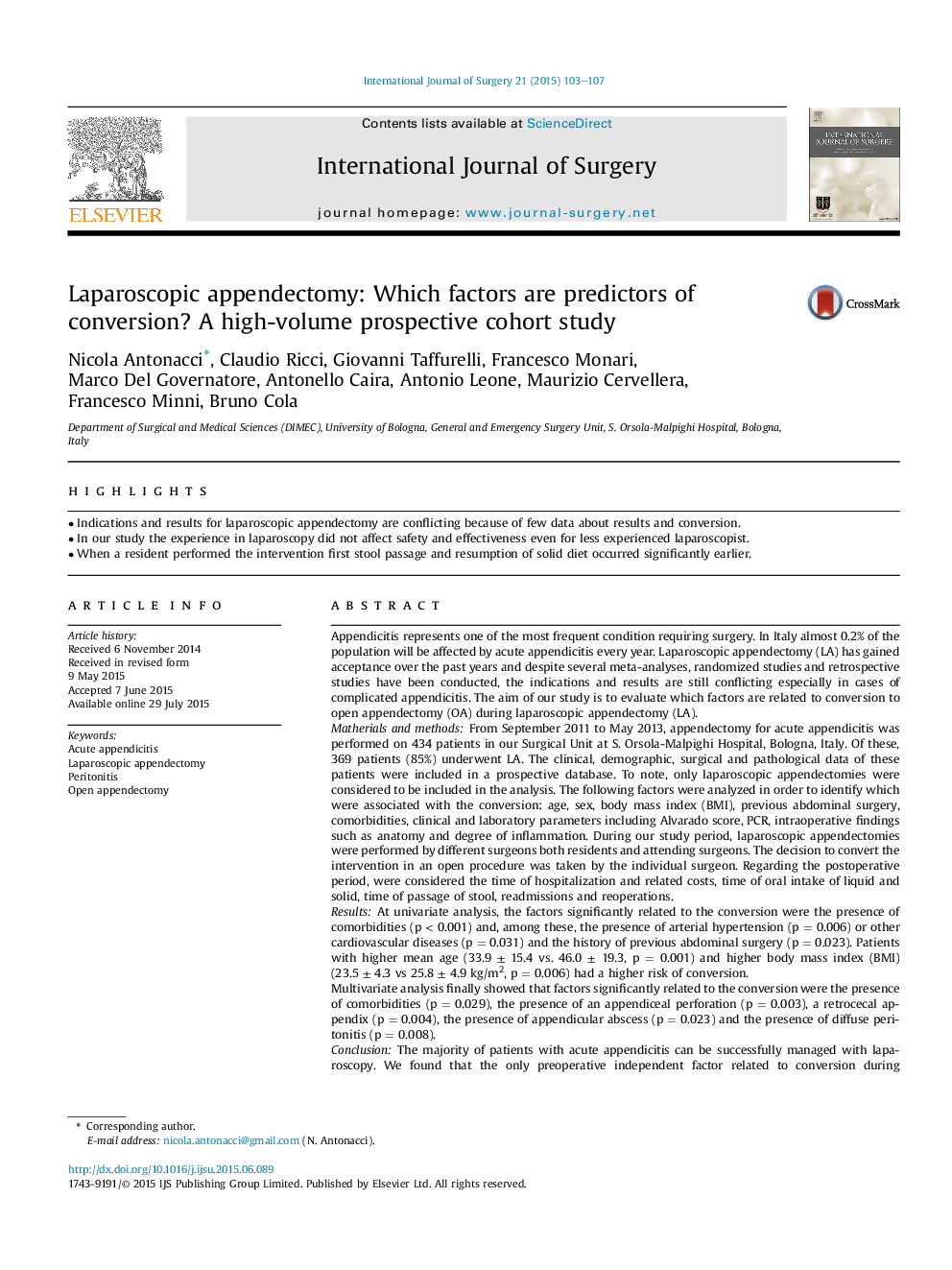| کد مقاله | کد نشریه | سال انتشار | مقاله انگلیسی | نسخه تمام متن |
|---|---|---|---|---|
| 6250940 | 1611971 | 2015 | 5 صفحه PDF | دانلود رایگان |
- Indications and results for laparoscopic appendectomy are conflicting because of few data about results and conversion.
- In our study the experience in laparoscopy did not affect safety and effectiveness even for less experienced laparoscopist.
- When a resident performed the intervention first stool passage and resumption of solid diet occurred significantly earlier.
Appendicitis represents one of the most frequent condition requiring surgery. In Italy almost 0.2% of the population will be affected by acute appendicitis every year. Laparoscopic appendectomy (LA) has gained acceptance over the past years and despite several meta-analyses, randomized studies and retrospective studies have been conducted, the indications and results are still conflicting especially in cases of complicated appendicitis. The aim of our study is to evaluate which factors are related to conversion to open appendectomy (OA) during laparoscopic appendectomy (LA).Matherials and methodsFrom September 2011 to May 2013, appendectomy for acute appendicitis was performed on 434 patients in our Surgical Unit at S. Orsola-Malpighi Hospital, Bologna, Italy. Of these, 369 patients (85%) underwent LA. The clinical, demographic, surgical and pathological data of these patients were included in a prospective database. To note, only laparoscopic appendectomies were considered to be included in the analysis. The following factors were analyzed in order to identify which were associated with the conversion: age, sex, body mass index (BMI), previous abdominal surgery, comorbidities, clinical and laboratory parameters including Alvarado score, PCR, intraoperative findings such as anatomy and degree of inflammation. During our study period, laparoscopic appendectomies were performed by different surgeons both residents and attending surgeons. The decision to convert the intervention in an open procedure was taken by the individual surgeon. Regarding the postoperative period, were considered the time of hospitalization and related costs, time of oral intake of liquid and solid, time of passage of stool, readmissions and reoperations.ResultsAt univariate analysis, the factors significantly related to the conversion were the presence of comorbidities (p < 0.001) and, among these, the presence of arterial hypertension (p = 0.006) or other cardiovascular diseases (p = 0.031) and the history of previous abdominal surgery (p = 0.023). Patients with higher mean age (33.9 ± 15.4 vs. 46.0 ± 19.3, p = 0.001) and higher body mass index (BMI) (23.5 ± 4.3 vs 25.8 ± 4.9 kg/m2, p = 0.006) had a higher risk of conversion.Multivariate analysis finally showed that factors significantly related to the conversion were the presence of comorbidities (p = 0.029), the presence of an appendiceal perforation (p = 0.003), a retrocecal appendix (p = 0.004), the presence of appendicular abscess (p = 0.023) and the presence of diffuse peritonitis (p = 0.008).ConclusionThe majority of patients with acute appendicitis can be successfully managed with laparoscopy. We found that the only preoperative independent factor related to conversion during laparoscopic appendectomy is the presence of comorbidities. Nevertheless surgeons should take into account that presence of peri-appendicular abscess and diffuse peritonitis are both independently related not only to higher rate of conversion but also to higher risk of postoperative complication.
Journal: International Journal of Surgery - Volume 21, September 2015, Pages 103-107
